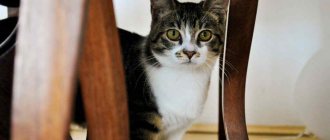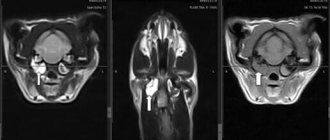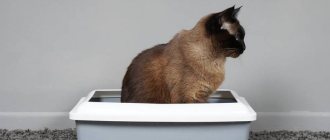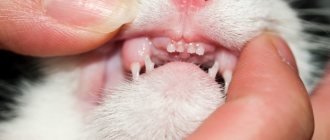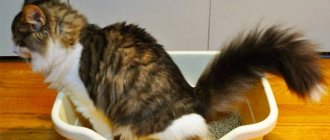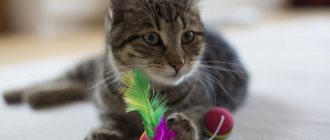Tripelphosphates - what is it and why are they dangerous?
Tripelphosphates in a cat's urine can only be detected in a veterinary laboratory by microscopic examination of the sediment or x-ray examination using a contrast agent. Considering the fact that not every pet owner has an idea of the mechanism of development of urolithiasis, it is worth understanding what tripel phosphates are and how they are dangerous for the animal.
Under the influence of a number of reasons, the metabolism in the cat’s body changes, urine becomes alkalized and ammonium salts of magnesium phosphate precipitate in the form of sand. Subsequently, in an alkaline environment, crystallization occurs and the rapid growth of phosphate stones occurs, which within a few days can fill the entire kidney of the animal. While tripelphosphates are in the kidney, they do not cause any disturbance to the pet due to their smooth, porous surface.
But with the flow of urine, stones enter other organs of the urinary system : ureters, bladder and urethra. The main danger of stones is that they block the urethra, causing the body to lose the vital need to excrete urine.
Stagnation of urine occurs, stretching of the walls of the bladder and rupture of blood vessels, as a result of which urine toxins enter the blood, causing poisoning of the entire body. Under the influence of toxins, the functioning of the cardiovascular, respiratory, digestive and nervous systems is disrupted, a coma occurs and the animal dies in agony.
Symptoms
Most often, the fact that a cat's urine contains tripelphosphates is discovered by chance during an examination for another reason or during a routine examination and testing. Symptoms of the pathological condition appear only when the disease has already progressed far (began to swell) and significant stones have formed. In such a situation, the main manifestations of the disease are :
- decreased appetite in the cat, which gradually leads to a complete refusal of food;
- depression - the cat begins to refuse even its favorite games and communication with people, even if up to this point it was active and sociable;
- frequent visits to the litter box, which produces urine of an unnatural color with a pungent odor;
- constant licking of the genital area and urethral outlet, which are irritated by urine containing tripelphosphates.
If you notice such strange behavior in your cat, you must urgently take the animal to the veterinarian so that the problem can be identified in a timely manner.
© shutterstock
Rules for collecting urine from cats
The main way to detect tripelphosphates is urine analysis, but the reliability of its results depends on the correctness of the analysis, storage conditions and time of delivery of the sample to the veterinary laboratory.
Rules for collecting urine from cats:
- For analysis, it is necessary to bring an average portion of morning urine collected immediately after a night's sleep.
- The external genitalia of your pet must be thoroughly washed with boiled water and laundry soap and dried well with a towel.
- The tray should also be treated with laundry soap and boiling water; it is not recommended to use chemicals to disinfect it, as they can negatively affect the results of laboratory tests.
- A special non-absorbent filler or plastic bag must be placed in the tray, from which urine must be collected with a sterile syringe.
What is a urine test and how is it performed?
Laboratory urine testing is prescribed to an animal for any pathology, for preventive purposes and to monitor the effectiveness of the prescribed treatment. So what is a urine test, why and how is it performed?
Metabolic products and various chemical compounds are excreted from the animal's body in urine. The laboratory assistant determines their presence and quantity in the submitted sample of biological fluid. In addition, the physical characteristics of urine, such as odor, color, clarity and density, are assessed, and microscopic examination of the sediment is carried out to identify red blood cells, white blood cells, casts, epithelial cells, crystals and amorphous masses of salts.
As a result of a comprehensive laboratory analysis, the veterinarian can judge the general health of the four-legged patient and various pathologies. Particular importance is given to urine analysis in the diagnosis of metabolic disorders, blood diseases, pathologies of the genitourinary and endocrine systems.
Causes of urolithiasis in cats
Most often, the pathology affects males aged 2-6 years; castrated cats are at risk; after sterilization, they experience metabolic disorders, obesity, narrowing of the urethra and congestive processes.
KSD in animals of both sexes over 10 years of age is most often caused by an infection of the genitourinary system. The main causes of urolithiasis in cats are:
- Incorrect feeding. The formation of stones is promoted by a high content of calcium, phosphorus, magnesium, sodium, proteins or carbohydrates in the animal diet. KSD is most often detected in cats that eat cheap ready-made food, fish, smoked, spicy, fried and fatty foods.
- Infectious and non-contagious diseases of the genitourinary system.
- Diseases of the endocrine system, hormonal imbalance, metabolic disorders.
- Insufficient consumption of clean drinking water in the absence of constant access to it.
- Urinary retention. Infrequent cleaning of dirty litter forces the cat to endure, resulting in stagnation and alkalization of urine with loss of crystals.
- Physical inactivity and obesity. Insufficient physical activity along with excess body weight leads to metabolic disorders and congestive processes in the kidneys.
- Using raw tap water rich in salts and microelements in your pet’s diet.
- Heredity. Unfortunately, pathology of the urinary system is inherited, so before purchasing a purebred kitten, it is recommended to check whether the animal’s parents had urolithiasis.
- Breed predisposition. Most often, Persian, Himalayan, Siamese, Burmese and Maine Coon cats suffer from urolithiasis.
- Geographical habitat area. The characteristics of soil, water and vegetation also influence the development of the disease. In our country, the largest percentage of sick animals occurs in the North Caucasus, Urals, Don and Volga.
- Congenital malformations of the urinary system.
Types of urinary formations and risk factors for their development
There are two types of stones diagnosed in cats:
- Struvite or tripelphosphates are salts of trivalent phosphorus. This type of urolith accounts for up to 80% of all stones formed. Most often, struvite urolithiasis is observed in cats. Solid crystals or loose amorphous compounds form in urine with a pH> 7 when there is an excess of phosphorus and magnesium in the diet. Adult cats from 1 to 6 years old become ill.
- Oxalates - salts of oxalic acid are formed in neutral or acidic urine when there is an excess of calcium in the diet. Older pets over 8 years of age are affected.
The occurrence of a mixed type of urolithiasis cannot be excluded. When both struvite and oxalates are present.
The following reasons for the development of ICD are identified:
- lack of drinking water: the concentration of salts increases; their excess precipitates;
- hard water containing a large amount of magnesium promotes the formation of struvite-type compounds;
- abuse of fish during natural feeding leads to excess phosphorus, which is not completely excreted in the urine and forms tripelphosphates;
- Abuse of calcium-rich dairy foods - kefir or cottage cheese - leads to excess calcium and the formation of oxalates.
In cats, urolithiasis occurs more often than in cats due to the anatomical features of the body. The long, winding urinary duct has more nooks and crannies in which a grain of sand can get stuck. A congestion forms, urine stagnates and microflora multiplies.
Be sure to read:
Kidney diseases in cats: types, what affects the appearance, symptoms, diagnosis, how to treat
A dead bacterial cell or a piece of exfoliated epithelium becomes a center of crystallization, on which layers grow, a large stone is formed that can completely block the outflow of urine. Conditions are created for the formation of kidney stones and the development of nephrolithiasis.
The predisposition of castrates to urolithiasis is explained by the fact that sterilization is carried out at the age of 6-9 months, when growth is not yet complete.
Live weight continues to increase, but the diameter of the ureter remains the same. If the operation had been performed at 12 months, there would have been no problems with the size of the urinary duct. But castration carried out after puberty has its drawbacks: the cat will mark the corners for some time, and the cat will meow invitingly.
An unbalanced diet, not only natural, but also ready-made economy-class food, predisposes to the formation of urinary stones.
Incomplete proteins are not fully absorbed; excess amino acids are converted into uric acid. which is poorly soluble on its own and reduces the solubility of other uric salts. This is why neutered cats need to be put on a diet for sterilized cats.
Symptoms and first signs of ICD in cats
The first signs of urolithiasis in cats can only be diagnosed by undergoing a preventive examination with a urine test. In the early stages, sand forms in the kidneys, which does not cause concern to the animal. In the absence of therapy, the disease becomes chronic, the stones enlarge and enter the organs of the urethra.
When a large number of stones form, move through the organs of the urinary system, or blockage of the urethra, the following characteristic symptoms of urolithiasis are observed:
- the animal's plaintive cry during urination;
- blood in urine;
- urinary incontinence;
- frequent futile attempts to empty the bladder;
- passing small amounts of urine;
- increased thirst;
- decreased appetite;
- strong smell of urine;
- lethargy.
You should not punish a cat for puddles on furniture or on the carpet; the act of urination causes extreme pain to the animal, and the pet searches in vain for any place where it can painlessly empty its bladder. This clinical picture is a reason to urgently contact a specialist.
If the urethra is blocked, the animal may die within 2-3 days; emergency measures must be taken for the following symptoms:
- lack of urine output;
- salivation;
- decrease in body temperature;
- oppression;
- vomit;
- convulsions;
- fainting;
- refusal of food;
- chills;
- shallow breathing;
- painful swelling of the peritoneum.
Treatment methods for urolithiasis in cats
Treatment of urolithiasis should be carried out only in a veterinary clinic; loss of precious time and self-medication can cost the life of a pet. The first step is pain relief, restoration of urine flow and removal of stones. Depending on the location and size of phosphate stones, the animal is prescribed conservative therapy or surgery.
Drug therapy
Most often, veterinary specialists try to remove stones using a non-surgical method with further prescription of drug therapy until the outflow of urine is completely restored and the symptoms of inflammation and intoxication are relieved. The main treatment regimen for feline urolithiasis:
- pain relief and spasm relief or general anesthesia;
- flushing the bladder and removing stones using a catheter;
- antibiotic therapy;
- removal of intoxication by drip infusion of physiological solutions;
- hemostatic therapy;
- use of anti-inflammatory drugs;
- prescription of vitamins and immunomodulators.
What is struvite in cats?
Older cats are susceptible to diseases of the excretory system. In addition to inflammation of the bladder and kidneys, pets often suffer from urolithiasis. (ICD). The cat's waste is eliminated in the form of salts in urine. Their solubility has its limits.
An increase in salt concentration, a change in pH, and the appearance of crystallization nuclei lead to the formation of solid deposits that impede the outflow of urine. Concretions are grouped into grains of sand or stones. They can clog the urinary duct, which poses a threat to the animal’s life.
Stones of different chemical compositions are formed in the urine of cats, but most often Struvite is formed. Therefore, the term is used when it comes to uroliths in general.
Types of uroliths
There are two types of urinary stones observed in cats:
- Struvites (Tripelphosphates).
- Oxalates are compounds of oxalic acid.
Struvite
Formed in alkaline urine. They represent a complex mixture of salts, in which ions of trivalent Phosphorus, as well as Calcium, Ammonium, and Magnesium predominate. Crystallization may be caused by dehydration.
https://www.youtube.com/watch?v=EdPJu0zq2Zo
Up to 80% of uroliths in cats are represented by Tripelphosphates. These are loose or hardened formations of yellow or cream color. Under a microscope, crystals with diamond-shaped edges are observed in the urine.
Struvite
Struvite can be dissolved with medication and is radiopaque, which makes conservative treatment of cats possible.
Oxalates
They are formed at acidic pH of urine, rapidly crystallize, and have a complex structure with sharp edges. Stones of increased hardness are difficult to dissolve, so conservative treatment is ineffective.
Oxalate urolite
Conditions for struvite formation
Struvite is formed under the influence of the following factors:
- Sufficient amount of mineral salts.
- Duration of stay in the lumen of the urinary canal.
- Ph urine > 7.0.
- There is protein in the urine.
Causes
The formation of stones provokes alkalosis. This condition of urine is caused by the following reasons:
- Unbalanced cat nutrition.
- Pathology of water and salt exchange.
- Congenital predisposition.
- Hormonal imbalance in a cat.
- Adynamia.
- Infectious diseases.
- Chronic pathologies.
Types of stones
Unbalanced diet
Excess protein with a shortage of energy supplied, mainly from carbohydrates, is utilized by putrefactive intestinal microflora, forming toxins that change the properties of urine. An important role is played by ensuring the need for essential amino acids, for example, Taurine, as well as vitamin A.
Pathology of water and salt metabolism
Fluid deficiency, its poor quality, and dehydration lead to an increase in the concentration of urinary salts. Chemical compounds precipitate from saturated solutions.
Congenital predisposition
Outbred cats, Persians, and Birmans are susceptible to urolithiasis.
Hormonal disbalance
Hypersecretion of Parathyroid hormone is accompanied by an increase in calcium concentration and an increase in urine pH, which provokes crystallization.
Adynamia
A sedentary existence leads to stagnation of fluids, increasing the risk of precipitation of sparingly soluble urine salts. Such cats are prone to obesity, diabetes, and pancreatitis. The indirect cause of adynamia is castration. Cats deprived of sexual motivation are prone to decreased mobility.
Infectious diseases
The penetration of conditionally pathogenic microbes from the blood, lymph or genitals causes inflammation of the excretory canals. Necrotic cells become crystallization nuclei.
Diagnostics
The presence of struvite in a cat is determined taking into account clinical signs, as well as additional information about the animal:
- Breed. Domestic cats, as well as Persians, their hybrids, and Birmans are susceptible to pathology.
- Age. Mostly animals over 6 years old are affected.
- Floor. Among cats, the disease occurs 6 times more often, which is due to anatomical features.
- Is the animal sterilized and at what age? When a cat is castrated early, the urethra remains underdeveloped, so the risk of blockage increases.
- Composition of the diet. The use of cheap ready-made food, natural food, especially with an abundance of fish and foods unusual for cats, increases the risk of urolith formation.
Using ultrasound or radiography, the location, type, shape, and number of stones are determined. Chemical analysis of urine, as well as crystallographic research, makes it possible to determine the type of stone and develop control measures.
Treatment
The therapeutic concept is developed based on clinical symptoms. If the urethra is blocked and the cat's condition is life-threatening, surgery is indicated. Responsible fellinologists deliver the pet to the clinic in a timely manner, and the veterinarian prescribes conservative treatment, which consists of dissolving the stones.
Surgical treatment
The following medical techniques are in demand:
- Catheterization. Emergency care for anuresis.
- Cystostomy. Removing stones from the urinary bladder.
- Urethrostomy. Elimination of obstruction of the urethra.
Catheterization
Conservative treatment
Measures to combat struvite in cats are as follows:
- Diet therapy.
- Organization of watering.
- Drug therapy.
With balanced feeding of the cat, the optimal pH of the urine is ensured, which prevents the precipitation of its components.
To compose a diet from natural products that have a healing effect, the high professional skill of a fellinologist is required. Therefore, it is better to use ready-made food for a cat suffering from urolithiasis.
Treating a sick pet to unusual food should be stopped - only dietary food.
Food for cats suffering from urolithiasis
It is necessary to pay attention to the organization of watering. It is better to drink bottled drinking water. The bowl needs to be washed daily, changing the drink 1…2 times a day.
Drug treatment consists of the following:
- General strengthening agents:
- To ensure the proper water-salt ratio, polyion mixtures are used.
- At the same time, antibacterial, anti-inflammatory, detoxification therapy is carried out.
- Antispasmodics - Drotaverine.
- Stone-breaking drugs:
- Erwin the cat. Extract from medicinal plants. It has a diuretic effect and destroys stones.
- Stop Cystitis. Phytosuspension. Prevents the formation of stones and dissolves existing ones.
- Anti-inflammatory and antiseptic agents prescribed by a veterinarian.
Kotervin
Diet and feeding rules for cats with ICD
After removal of stones by conservative or surgical means, the animal must be on a special diet for the rest of its life to prevent the formation of stones in the organs of the urinary system.
Rules for feeding a cat with ICD
- The best option is to use ready-made wet food designed for feeding animals with urolithiasis.
- A prerequisite is to ensure that the cat has constant access to a bowl of fresh filtered water, which should be changed at least 2 times a day.
- It is unacceptable to mix ready-made food with natural products.
- When choosing a traditional diet, it is necessary to reduce the content of eggs, dairy products, offal, eliminate smoked, fried, fatty and spicy foods. The cat can be fed boiled beef, lamb, veal, chicken, white fish with the addition of rice, buckwheat or oatmeal, carrots, beets and cauliflower.
Treatment of urolithiasis
The goal of therapy for a sick cat is to improve his condition by eliminating pain and difficulty urinating, to break down existing stones and remove them out, to prevent the formation of new stones, to eliminate all complications that have arisen (inflammation, wounds in the urethra, suppuration, etc.) If such problems cannot be solved through medications, then surgery is performed.
Nutrition correction
Diet therapy is an important part of the comprehensive treatment of a cat with urolithiasis. The nutrition of sick animals is not standardized - the diet is compiled for each animal separately, taking into account the deposition of which substances led to the formation of stones. When drawing up a diet, the cat’s age, gender, breed, stage of the disease, and the presence of complications are taken into account.
A prerequisite is to limit food with a high content of substances that lead to the formation of stones. If the stones contain calcium compounds, phosphorus and ethanedioic acid, then eggs, offal, cottage cheese, yogurt, and sour cream are excluded from the diet. Urates will increase from foods with a high content of salts and purine, so you should not give your cat fatty meat broths, liver sausage, liver, or fish (especially canned fish).
A sick cat needs carbohydrates, so the basis of the diet should be meat food. Fresh or boiled vegetables can be given in small quantities.
Special feed
Food for an animal with urolithiasis must be of high quality, balanced, and nutritious. It is better to buy special food that helps crush stones:
- Hill's Prescription Diet. It is based on turkey or chicken meat, corn gluten, minerals safe for a sick cat, protein hydrolysate, fish oil, beta-carotene. The price of a 400 gram package is from 350 rubles. This series of foods has options for feeding cats with diagnosed urolithiasis: S/D Feline Urinary-Disolution,
- C/D Urinary Care Multicare.
The Hills line includes food c/d Urinary Care Multicare - it is designed specifically for cats with urolithiasis
- dry food with poultry flavor (price from 296 rubles per 400 gram package),
Feed suitable for breaking down calcium oxalates and preventing urolithiasis
Drug treatment
For cats with urinary retention, it is important to provide symptomatic assistance with emptying the urinary organs. To do this, catheterization is carefully performed, the bladder cavity is washed with a warm Furacilin solution, and an antibiotic (for example, Kirin) is administered intramuscularly. These procedures are performed regularly until the cat begins to go to the toilet on its own. For general strengthening, they give B vitamins and ascorbic acid. For severe pain, antispasmodics (Baralgin, Atropine, Platyfillin, Spazmolitin) are used or a novocaine blockade is given.
In the first stages of urolithiasis, animals are given drugs that can soften small stones. In each case, medications are selected individually, taking into account the composition of the stones, gender, and age of the animal. Crushing can also be carried out using physiotherapeutic methods - for example, using wave lithotripsy. Methods that break down stones must be combined with the use of diuretics (Furosemide, Lasix, Mannitol) - medications that allow you to remove sand.
In case of complications, cats need measures to relieve the symptoms of urea intoxication and eliminate the threat of acute renal failure (hemodialysis is performed, based on the diffusion of urea, creatinine, uric acid, and electrolytes from the blood). Intrarenal blood flow is restored (ACE blockers are administered). Renal acidosis is eliminated with sodium bicarbonate solution.
Clinical example: mongrel cat Styopa (5 years old) - difficulty urinating, refusal of water and food. The urine is clear, pH 5.8; microscopy reveals accumulations of oxalates. The doctor prescribed the following drugs: Nitroxoline, a quarter of a tablet twice a day for a week, a solution of Phytolysin, a teaspoon twice a day for two weeks, Neurovital, 1/4 of a tablet in the morning and evening (9 days); intramuscular Baralgin 0.5 ml for 5 days. The veterinarian said that during treatment, exclude fish and dairy products from the diet, and focus on dishes with turkey, herbs, and soft vegetables. On the 6th day of therapy, the cat’s urination was restored and his appetite returned. Tested after 12 days, no oxalate stones were found in the sediment.
Surgery
If drug therapy has not brought results after 2 months or when the animal experiences severe pain, there is a threat of acute dysuria and bleeding - surgical intervention is indicated. First, a retropulsive flushing method is tried, the purpose of which is to push the stone back into the bladder, where it can be broken up with medications or an ultrasonic wave. To do this, a catheter is inserted into the urethra and 15–20 ml of warm saline is injected through it. If catheterization does not help improve the animal’s condition or signs of complications are observed, the cat is given:
- Cystomy when stones are localized in the bladder cavity. The surgeon makes a retroumbilical paramedian incision and opens the organ. Remains of urine are removed by suction, stones are removed with tweezers, sand is removed by rinsing with saline and simultaneous aspiration. The operation lasts 40–70 minutes.
- Urethrostomy when solid accumulations are detected in the urethra. During the operation, the surgeon makes an opening (urethrostomy) between the wide part of the urethra and the skin of the abdominal wall. The procedure is performed under general anesthesia and lasts 30–45 minutes.
If the urethra is severely damaged (severe blockage or narrowing of the canal), amputation of the penis is recommended. This is a radical procedure - it is carried out when other measures are not able to ensure the rapid and unhindered passage of urine, sand, and stones.
How to help a small kitten
In young animals, urolithiasis mainly manifests itself due to heredity, untreated trauma to the genitourinary organs, or severe hypothermia (urolithiasis often develops in kittens picked up on the street in severe frosts). The treatment regimen in this case will not differ from the treatment of adult cats. The only thing is that it is difficult for children to install catheters due to the small size of the urethra, and therefore if there is acute urinary retention and it is not eliminated with medication, the patient is immediately sent for surgery.
Prevention measures and features of keeping an animal with urolithiasis
KSD is a chronic disease that causes a lot of suffering to pets and their owners, but if preventive measures, feeding and maintenance conditions are observed, even with a diagnosis of urolithiasis, a pet can live a long, carefree life.
Features of keeping an animal with ICD:
- The cat must have constant access to fresh water.
- It is recommended to clean the tray in a timely manner to avoid urinary retention in your pet.
- The owner needs to control the weight of the furry pet.
- It is unacceptable to overfeed the animal or treat it to prohibited foods.
- It is recommended to encourage the animal to play actively to eliminate the risk of developing stagnant processes.
- It is worth treating chronic and infectious diseases in a timely manner, avoiding drafts and hypothermia.
- An animal diagnosed with ICD must be brought annually for a preventive examination to a veterinary clinic with mandatory laboratory testing of urine and blood tests.

